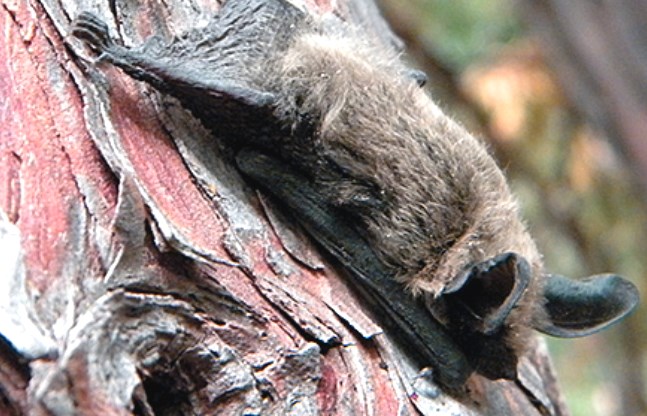Last updated: November 7, 2019
Article
Bat Acoustic Monitoring at Agate Fossil Beds National Monument

NPS
Overview
Agate Fossil Beds National Monument safeguards Miocene Epoch mammal fossils and the prairie ecosystem in western Nebraska. The Niobrara River is stream-like as it passes through the center of the 3,058-acre park and, although the primary habitat found at Agate Fossil Beds National Monument is Northern Great Plains mixed-grass prairie, there are small groves of old cottonwoods in the floodplain of the Niobrara River that provide good roosting and foraging habitat for bats.
The Northern Great Plains Inventory & Monitoring Network monitors bats to detect long-term trends and to get early warning of undesirable changes in bat populations at the park. A fungal disease called white-nose syndrome is spreading quickly, threatening bat populations in North America. First documented in a New York cave in 2006, this disease is associated with more than seven million bat deaths. It spreads primarily from bat to bat and humans might be spreading the disease by carrying nearly invisible fungal spores on their shoes and clothing from one cave to another. Bat monitoring can help us understand changes occurring with the spread of this devastating disease.
Acoustic Monitoring
Forty-three acoustic recording stations were set up in 2015 and 2016 at Agate Fossil Beds National Monument to study bat summer habitat use. Acoustic recorders detect the unique ultrasonic calls bats use for echolocation. There were 67,917 bat call recordings from stations across all survey nights from 2015 to 2017. The data were analyzed through specialized software programs that make preliminary identifications of the bat species based on individual call characteristics, such as frequency and shape. Some bat species make calls that are similar to other species, which is why researchers with special expertise review the calls and make the final species determinations.

NPS
Bats at the Park (2015-2017)
| Common Name | Scientific Name | 2015–2017 Status |
|---|---|---|
| Big brown bat | Eptesicus fuscus | Present |
| Eastern red bat | Lasiurus borealis | Present |
| Hoary bat | Lasiurus cinereus | Present |
| Silver-haired bat | Lasionycteris noctivagans | Present |
| Western small-footed myotis | Myotis ciliolabrum | Present |
| Little brown bat | Myotis lucifugus | Present |
| Long-legged myotis | Myotis volans | Present |
| Evening bat | Nycticeius humeralis | Probably Present |
| Tri-colored bat | Perimyotis subflavus | Present |
- Big brown, silver-haired, and hoary bats were were recorded more often than other species. The park wwas previously considered outside the range of big brown bats. Listen to a big brown bat call!
- Hoary bat, long-legged myotis, evening bat, and tri-colored bat were new detections for the park.
- Northern long-eared bats (Myotis septentrionalis) were previously reported as probably present, but could not be confirmed in this study. Since this species has suffered a dramatic decline in recent years, it may no longer be present or may be an infrequent park visitor. The northern long-eared bat (Myotis septentrionalis) is one of the species of bats most impacted by white-nose syndrome.
- The highest rates of detection were at stations near trees and water where more roosting and foraging resources are found. In particular, the station in the cottonwood grove recorded a significantly higher than average number of bat calls. Without the cottonwood grove and the trees planted near the park buildings, there would likely be less bat activity at the Agate Fossil Beds National Monument.

NPS
White-nose Syndrome
White-nose syndrome has not yet been detected at the park, but the fungus (Pseudogymnoascus destructans) that causes it was detected in 2017 on bats at Badlands National Park, less than 100 miles northeast of Agate Fossil Beds National Monument. See a map of white-nose syndrome in national parks and learn more about how you can help prevent the spread of this fungus. Continued monitoring, and park staff and visitor observations, will help us protect the bat communities that live and forage in the park.
For More Information
Dan Licht, Midwest Region Wildlife Biologist
Protocol Contact: Northern Great Plains Network
Summary by Tani Hubbard, updated in 2019
